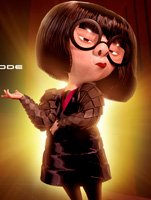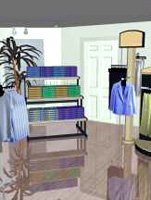Patternmakers, Merchandisers Look to the Future of 3-D
Three-dimensional technology for the apparel industry is getting a push from the entertainment industry.
Emeryville, Calif.–based Pixar Animation Studios, in conjunction with Burbank, Calif.–based The Walt Disney Co., is using CAD/CAM technology from Montreal-based PAD System Technologies Inc. to develop garments for animated characters in the upcoming feature “The Incredibles,” due out in November. This movie, about a family of super heroes, will be the first in Pixar’s portfolio of cutting-edge animated films to feature realistic human protagonists. The lifelike characters will have beard stubble, tousled hair and flapping clothing. One character, Edna Mode, is a fashion designer, so Pixar paid extra attention to creating detailed garments.
Pixar used PAD’s Haute Couture 3D Studio module and Master Pattern Design to construct pieces and then brought the characters to life using proprietary technologies and applications from other vendors.
The result is expected to reach a new level of 3-D animation and may also give the apparel industry some insight into how to take 3-D to the next level.
Recent advancements already have refined the apparel product development process. Several companies have integrated 3-D applications into their CAD programs to help patternmakers visualize creations and streamline the trial-and-error process that is often part of garment construction.
PAD’s Haute Couture 3D is now enhanced with a Syflex LLC simulating engine that shows the bends and creases of garments during movement. New York–based OptiTex USA Inc. has borrowed technology from Waltham, Mass.–based Vistagy Inc. to improve graphics for applications involving rigid fabrics. Last year, Gerber Technology Inc. entered into a venture with Browzwear to incorporate the V-Stitcher 3-D tool into Gerber’s patternmaking products. The goal is to reduce iterations and give patternmakers and designers better visualization to streamline the product development process.
“It’s not so much the time you’re saving as the mistakes,” said PAD’s Julie Lefebvre. “It can help determine if a print looks too big or if a certain pocket is in the wrong place. Of course, it’s not as conclusive as an actual sample, but it’s a pretty good sounding board.”
The growing interest in 3-D was apparent at last month’s SPESA/Material World expo in Miami, where CAD vendors reported brisk business with companies selling products right out of the box.
Technology companies are also experiencing success with other uses of 3-D. Bordeaux, France–based Lectra has 3D Visual Merchant, which allows retailers to visualize store layouts and merchandising by crafting onscreen models with fixtures, garments, racks and even signage. Little Rock, Ark.– based retailer Dillard’s Inc. has been using the application to improve merchandising strategies.
PAD’s 3-D technology is helping clients present collections beyond the pattern-making stage.
PAD’s Canadian neighbor My Virtual Model has enhanced its 3-D technology to cater to a broad range of customers, including plus-size consumers. Visitors to Web sites using the company’s technology can create 3-D models of themselves that they can outfit with clothing.
As Pixar takes 3-D animation to a higher level, the apparel industry and other industries may soon apply some of the company’s advancements to their business models. Companies may soon use laptop computers to see virtual models strolling down the catwalk in next season’s collections. But bringing animation into the apparel industry may not come for some time because it is too expensive right now, Lefebvre said.
Demand may bring pricing and availability to a more feasible level. For now, the use of 3-D in product development is still hot even in its infancy.
























